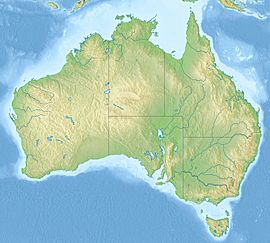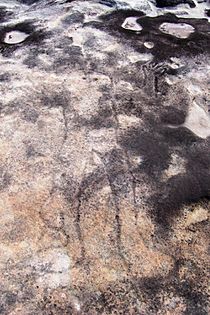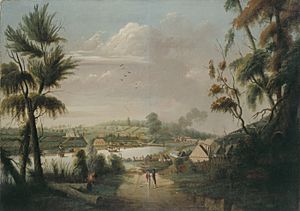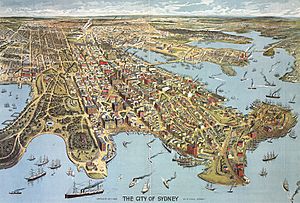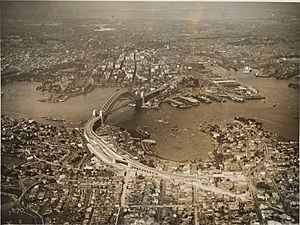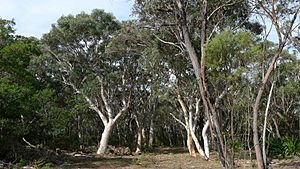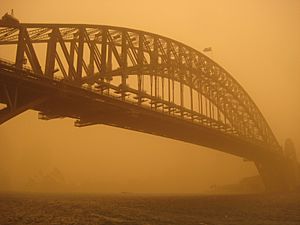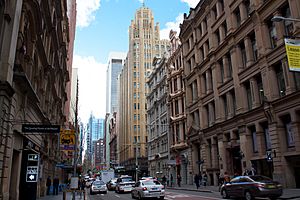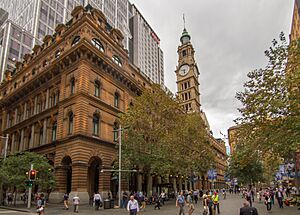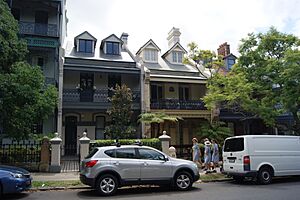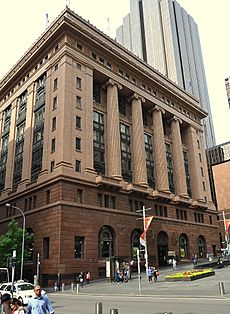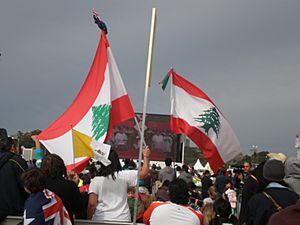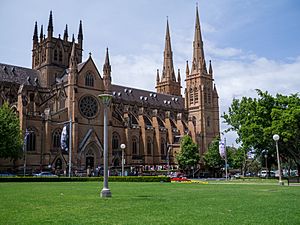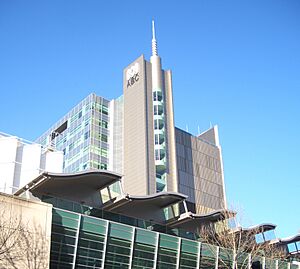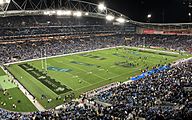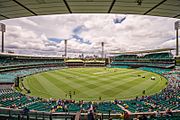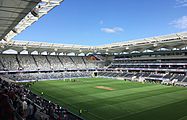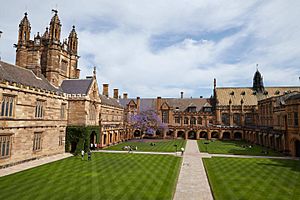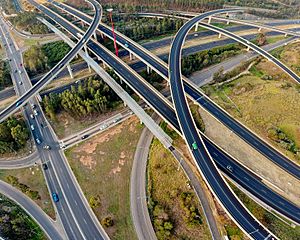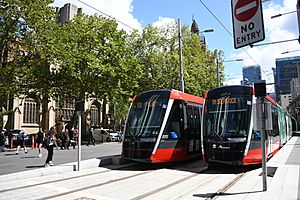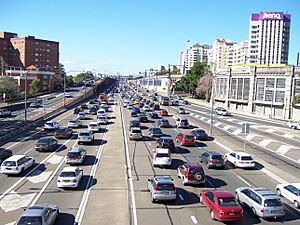Sydney facts for kids
Quick facts for kids SydneyNew South Wales |
|||||||||
|---|---|---|---|---|---|---|---|---|---|
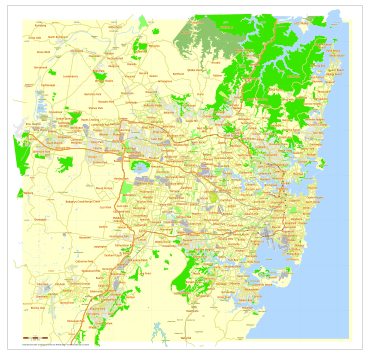
Map of the Sydney metropolitan area
|
|||||||||
| Population | 5,450,496 (2023) (1st) | ||||||||
| • Density | 441/km2 (1,140/sq mi) (2023) | ||||||||
| Established | 26 January 1788 | ||||||||
| Area | 12,367.7 km2 (4,775.2 sq mi)(GCCSA) | ||||||||
| Time zone | AEST (UTC+10) | ||||||||
| • Summer (DST) | AEDT (UTC+11) | ||||||||
| Location | |||||||||
| LGA(s) | Various (33) | ||||||||
| County | Cumberland | ||||||||
| State electorate(s) | Various (49) | ||||||||
| Federal Division(s) | Various (24) | ||||||||
|
|||||||||
Sydney is the capital city of the state of New South Wales and the most populous city in Australia and Oceania. Located on Australia's east coast, the metropolis surrounds Sydney Harbour and extends about 80 km (50 mi) from the Pacific Ocean in the east to the Blue Mountains in the west, and about 80 km (50 mi) from the Ku-ring-gai Chase National Park and the Hawkesbury River in the north and north-west, to the Royal National Park and Macarthur in the south and south-west. Greater Sydney consists of 658 suburbs, spread across 33 local government areas. Residents of the city are colloquially known as "Sydneysiders". The estimated population in June 2023 was 5,450,496, which is about 66% of the state's population. The city's nicknames include the Emerald City and the Harbour City.
Aboriginal Australians have inhabited the Greater Sydney region for at least 30,000 years, and their engravings and cultural sites are common. The traditional custodians of the land on which modern Sydney stands are the clans of the Darug, Dharawal and Eora peoples. During his first Pacific voyage in 1770, James Cook charted the eastern coast of Australia, making landfall at Botany Bay. In 1788, the First Fleet of convicts, led by Arthur Phillip, founded Sydney as a British penal colony, the first European settlement in Australia. After World War II, Sydney experienced mass migration and by 2021 over 40 per cent of the population was born overseas. Foreign countries of birth with the greatest representation are mainland China, India, the United Kingdom, Vietnam and the Philippines.
Despite being one of the most expensive cities in the world, Sydney frequently ranks in the top ten most liveable cities. It is classified as an Alpha+ city by the Globalization and World Cities Research Network, indicating its influence in the region and throughout the world. Ranked eleventh in the world for economic opportunity, Sydney has an advanced market economy with strengths in education, finance, manufacturing and tourism. The University of Sydney and the University of New South Wales are ranked 18th and 19th in the world respectively.
Sydney has hosted major international sporting events such as the 2000 Summer Olympics, the 2003 Rugby World Cup Final, and the 2023 FIFA Women's World Cup Final. The city is among the top fifteen most-visited, with millions of tourists coming each year to see the city's landmarks. The city has over 1,000,000 ha (2,500,000 acres) of nature reserves and parks, and its notable natural features include Sydney Harbour and Royal National Park. The Sydney Harbour Bridge and the World Heritage-listed Sydney Opera House are major tourist attractions. Central Station is the hub of Sydney's suburban train, metro and light rail networks and longer-distance services. The main passenger airport serving the city is Kingsford Smith Airport, one of the world's oldest continually operating airports.
Contents
Toponymy
In 1788, Captain Arthur Phillip, the first governor of New South Wales, named the cove where the first British settlement was established Sydney Cove after Home Secretary Thomas Townshend, 1st Viscount Sydney. The cove was called Warrane by the Aboriginal inhabitants. Phillip considered naming the settlement Albion, but this name was never officially used. By 1790 Phillip and other officials were regularly calling the township Sydney. Sydney was declared a city in 1842.
The Gadigal (Cadigal) clan, whose territory stretches along the southern shore of Port Jackson from South Head to Darling Harbour, are the traditional owners of the land on which the British settlement was initially established, and call their territory Gadi (Cadi). Aboriginal clan names within the Sydney region were often formed by adding the suffix "-gal" to a word denoting the name for their territory, a specific place in their territory, a food source, or totem. Greater Sydney covers the traditional lands of 28 known Aboriginal clans.
History
First inhabitants
The first people to inhabit the area now known as Sydney were indigenous Australians having migrated from northern Australia and before that from southeast Asia. Radiocarbon dating suggests human activity first started to occur in the Sydney area from around 30,735 years ago. However, numerous Aboriginal stone tools were found in Western Sydney's gravel sediments that were dated from 45,000 to 50,000 years BP, which would indicate that there was human settlement in Sydney earlier than thought.
The earliest British settlers called them Eora people. "Eora" is the term the indigenous population used to explain their origins upon first contact with the British. Its literal meaning is "from this place". Prior to the arrival of the British there were 4,000 to 8,000 native people in Sydney from as many as 29 different clans.
Sydney Cove from Port Jackson to Petersham was inhabited by the Cadigal clan. The principal language groups were Darug, Guringai, and Dharawal. The earliest Europeans to visit the area noted that the indigenous people were conducting activities such as camping and fishing, using trees for bark and food, collecting shells, and cooking fish.
Development has destroyed much of the city's history including that of the first inhabitants. There continues to be examples of rock art and engravings located in the protected Ku-ring-gai Chase National Park. The first meeting between the native people and the British occurred on 29 April 1770 when Lieutenant James Cook landed at Botany Bay on the Kurnell Peninsula and encountered the Gweagal clan. He noted in his journal that they were confused and somewhat hostile towards the foreign visitors. Cook was on a mission of exploration and was not commissioned to start a settlement. He spent a short time collecting food and conducting scientific observations before continuing further north along the east coast of Australia and claiming the new land he had discovered for Britain.
Establishment of the colony
Britain—before that, England—and Ireland had for a long time been sending their convicts across the Atlantic to the American colonies. That trade was ended with the Declaration of Independence by the United States in 1776. Overrun with prisoners, Britain decided in 1786 to found a new penal outpost in the territory discovered by Cook some 16 years earlier.
The colony was at first to be titled "New Albion", but Phillip decided on "Sydney" in recognition of The 1st Baron Sydney—later created The 1st Viscount Sydney in 1789—and his role in authorising the establishment of the settlement. Captain Philip led the First Fleet of 11 ships and about 850 convicts into Botany Bay on 18 January 1788, though deemed the location unsuitable due to poor soil and a lack of fresh water. He travelled a short way further north and arrived at Port Jackson on 26 January 1788. This was to be the location for the new colony. Phillip described Sydney Cove as being "without exception the finest harbour in the world". The official proclamation and naming of the colony happened on 7 February 1788.
Between 1788 and 1792 about 4,300 convicts were landed at Sydney. The colony was not founded on the principles of freedom and prosperity. Maps from this time show no prison buildings; the punishment for convicts was transportation rather than incarceration, but serious offences were penalised by flogging and hanging.
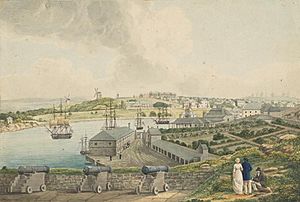
Officers and convicts alike faced starvation as supplies ran low and little could be cultivated from the land. The region's indigenous population was also suffering. It is estimated that half of the native people in Sydney died during the smallpox epidemic of 1789. Some mounted violent resistance to the British settlers. Lachlan Macquarie became Governor in 1810.
Macquarie did make the most of less than ideal circumstances. His first task was to restore order after the Rum Rebellion of 1808 against the previous Governor. Conditions in the colony were not conducive to the development of a thriving new metropolis, but the more regular arrival of ships and the beginnings of maritime trade (such as wool) helped to lessen the burden of isolation.
Macquarie undertook an extensive building programme of some 265 separate works. Roads, bridges, wharves, and public buildings were constructed using convict labour and come 1822 the town had banks, markets, and well-established thoroughfares. Part of Macquarie's effort to transform the colony was his authorisation for convicts to re-enter society as free citizens.
Modern development
The year 1840 was the final year of convict transportation to Sydney, which by this time had a population of 35,000. The municipal council of Sydney was incorporated in 1842 and became Australia's first city. Gold was discovered in the colony in 1851 and with it came thousands of people seeking to make money. Sydney's population reached 200,000 by 1871.
Following the depression of the 1890s, the six colonies agreed to form a federated nation of The Commonwealth of Australia. Under the reign of Queen Victoria federation of the six colonies occurred on 1 January 1901. Sydney, with a population of 481,000, then became the state capital of New South Wales.
The Great Depression of the 1930s had a severe effect on Sydney's economy, as it did with most cities throughout the industrial world. For much of the 1930s up to one in three breadwinners was unemployed. Construction of the Sydney Harbour Bridge served to alleviate some of the effects of the economic downturn by employing 1,400 men between 1924 and 1932. The population continued to boom despite the Depression and reached 1 million in 1925.
When Britain declared war on Germany in 1939, Australia too entered. During the war Sydney experienced a surge in industrial development to meet the needs of a wartime economy. Far from mass unemployment, there were now labour shortages and women becoming active in male roles. Sydney's harbour was attacked by the Japanese in May and June 1942 with a direct attack from Japanese submarines with some loss of life. Households throughout the city had built air raid shelters and performed drills.
Following the end of the war the city continued to expand. There were 1.7 million people living in Sydney at 1950 and almost 3 million by 1975. The people of Sydney warmly welcomed Queen Elizabeth II in 1954 when the a reigning monarch stepped onto Australian soil for the first time to commence her Australian Royal Tour. Having arrived on the Royal Yacht Britannia through Sydney Heads, Her Majesty came ashore at Farm Cove. Sydney's iconic Opera House was opened in 1973 by Her Majesty.
A strong rivalry between Sydney and Melbourne that began in the 1850s still exists to this day. Sydney exceeded Melbourne's population in the early twentieth century and remains Australia's largest city. The 2000 Summer Olympics were held in Sydney and became known as the "best Olympic Games ever" by the President of the International Olympic Committee. The Opera House became a World Heritage Site in 2007.
Geography
Topography

Sydney is a coastal basin with the Tasman Sea to the east, the Blue Mountains to the west, the Hawkesbury River to the north, and the Woronora Plateau to the south. The inner city measures 25 square kilometres (10 square miles), the Greater Sydney region covers 12,367 square kilometres (4,775 square miles), and the city's urban area is 1,687 square kilometres (651 square miles) in size.
Sydney spans two geographic regions. The Cumberland Plain lies to the south and west of the Harbour and is relatively flat. The Hornsby Plateau is located to the north and is dissected by steep valleys. The flat areas of the south were the first to be developed as the city grew. It was not until the construction of the Sydney Harbour Bridge that the northern reaches of the coast became more heavily populated. Seventy beaches can be found along its coastline with Bondi Beach being one of the most famous.
The Nepean River wraps around the western edge of the city and becomes the Hawkesbury River before reaching Broken Bay. Most of Sydney's water storages can be found on tributaries of the Nepean River. The Parramatta River is mostly industrial and drains a large area of Sydney's western suburbs into Port Jackson. The southern parts of the city are drained by the Georges River and the Cooks River into Botany Bay.
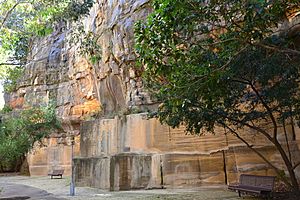
Geology
Sydney is made up of mostly Triassic rock with some recent igneous dykes and volcanic necks. The Sydney Basin was formed when the Earth's crust expanded, subsided, and filled with sediment in the early Triassic period. The sand that was to become the sandstone of today was washed from Broken Hill and laid down about 200 million years ago. The sandstone has shale lenses and fossil riverbeds.
The Sydney Basin bioregion includes coastal features of cliffs, beaches, and estuaries. Deep river valleys known as rias were carved during the Triassic period in the Hawkesbury sandstone of the coastal region where Sydney now lies. The rising sea level between 18,000 and 6,000 years ago flooded the rias to form estuaries and deep harbours. Port Jackson, better known as Sydney Harbour, is one such ria.
Vegetation
The most prevalent plant communities in the Sydney region are Dry Sclerophyll Forests, which consist of eucalyptus trees mainly in an open woodland setting, sclerophyll shrubs (typically wattles and banksias) and a semi-continuous grass in the understory. These plants tend to have rough and spiky leaves, as they're grown in areas with low soil fertility. Wet sclerophyll forests are found in the damp, elevated areas of Sydney, such as in the northeast. They are defined by straight, tall tree canopies with an elaborate, moist understorey of soft-leaved shrubs, tree ferns and herbs.
Climate
Under the Köppen–Geiger classification, Sydney has a humid subtropical climate (Cfa) with warm summers, winters and uniform rainfall throughout the year. At Sydney's primary weather station at Observatory Hill, extreme temperatures have ranged from 45.8 °C (114.4 °F) on 18 January 2013 to 2.1 °C (35.8 °F) on 22 June 1932; whereas at the Sydney Airport station, extremes have ranged from 46.4 to −0.1 °C (115.5 to 31.8 °F). An average of 14.9 days a year have temperatures at or above 30 °C (86 °F) in the CBD. In contrast, the metropolitan area averages between 35 and 65 days, depending on the suburb. The highest minimum temperature recorded at Observatory Hill is 27.6 °C (82 °F), in February 2011 while the lowest maximum temperature is 7.7 °C (46 °F), recorded in July 1868.
The weather is moderated by proximity to the ocean, and more extreme temperatures are recorded in the inland western suburbs. Sydney experiences an urban heat island effect. This makes certain parts of the city more vulnerable to extreme heat. In late spring and summer, temperatures over 35 °C (95 °F) are not uncommon, though hot, dry conditions are usually ended by a southerly buster. This powerful storm brings gale winds and rapid fall in temperature, followed by brief heavy rain and thunder. Due to the inland location, frost is recorded in Western Sydney a few times in winter. Autumn and spring are the transitional seasons, with spring showing a larger temperature variation than autumn.
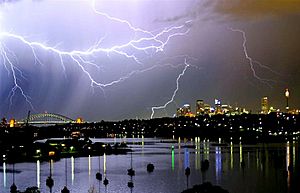
The rainfall has a moderate to low variability and it is evenly spread through the months, though is slightly higher during the first half of the year. From 1990–1999, Sydney received around 20 thunderstorms per year. In late autumn and winter, east coast lows may bring large amounts of rainfall, especially in the CBD. Depending on the wind direction, summer weather may be humid or dry, with the late summer/autumn period having a higher average humidity and dewpoints than late spring/early summer. In summer, most rain falls from thunderstorms and in winter from cold fronts. Snowfall was last reported in the Sydney City area in 1836, while a fall of graupel, or soft hail, mistaken by many for snow, in July 2008, has raised the possibility that the 1836 event was not snow, either.
The city is rarely affected by cyclones, although remnants of ex-cyclones do affect the city. The El Niño–Southern Oscillation plays an important role in determining Sydney's weather patterns: drought and bushfire on the one hand, and storms and flooding on the other, associated with the opposite phases of the oscillation. Many areas of the city bordering bushland have experienced bushfires, these tend to occur during the spring and summer. The city is also prone to severe storms. One such storm was the 1999 hailstorm, which produced massive hailstones of at least 9 cm (3.5 in) in diameter.
The Bureau of Meteorology has reported that 2002 through 2005 were the warmest summers in Sydney since records began in 1859. The summer of 2007–08, however, proved to be the coolest since 1996–97 and is the only summer this century to be at or below average in temperatures. In 2009, dry conditions brought a severe dust storm towards eastern Australia. The average annual temperature of the sea is above 21 °C (70 °F), and the monthly average ranges from 18 °C (64 °F) in July to 24 °C (75 °F) in January.
| Climate data for Sydney | |||||||||||||
|---|---|---|---|---|---|---|---|---|---|---|---|---|---|
| Month | Jan | Feb | Mar | Apr | May | Jun | Jul | Aug | Sep | Oct | Nov | Dec | Year |
| Record high °C (°F) | 45.3 (113.5) |
42.1 (107.8) |
39.8 (103.6) |
33.9 (93.0) |
30.0 (86.0) |
26.9 (80.4) |
25.9 (78.6) |
31.3 (88.3) |
34.6 (94.3) |
38.2 (100.8) |
41.8 (107.2) |
42.2 (108.0) |
45.3 (113.5) |
| Mean daily maximum °C (°F) | 25.9 (78.6) |
25.8 (78.4) |
24.7 (76.5) |
22.4 (72.3) |
19.4 (66.9) |
16.9 (62.4) |
16.3 (61.3) |
17.8 (64.0) |
20.0 (68.0) |
22.1 (71.8) |
23.6 (74.5) |
25.2 (77.4) |
21.7 (71.1) |
| Mean daily minimum °C (°F) | 18.7 (65.7) |
18.8 (65.8) |
17.5 (63.5) |
14.7 (58.5) |
11.5 (52.7) |
9.3 (48.7) |
8.0 (46.4) |
8.9 (48.0) |
11.1 (52.0) |
13.5 (56.3) |
15.6 (60.1) |
17.5 (63.5) |
13.8 (56.8) |
| Record low °C (°F) | 10.6 (51.1) |
9.6 (49.3) |
9.3 (48.7) |
7.0 (44.6) |
4.4 (39.9) |
2.1 (35.8) |
2.2 (36.0) |
2.7 (36.9) |
4.9 (40.8) |
5.7 (42.3) |
7.7 (45.9) |
9.1 (48.4) |
2.1 (35.8) |
| Average rainfall mm (inches) | 101.5 (4.00) |
118.7 (4.67) |
128.9 (5.07) |
125.8 (4.95) |
121.1 (4.77) |
130.7 (5.15) |
97.3 (3.83) |
81.2 (3.20) |
69.1 (2.72) |
77.6 (3.06) |
83.1 (3.27) |
77.8 (3.06) |
1,212.8 (47.75) |
| Average rainy days (≥ of ANY volume) | 12.2 | 12.4 | 13.5 | 12.8 | 13.2 | 12.5 | 11.1 | 10.5 | 10.6 | 11.6 | 11.6 | 11.5 | 143.5 |
| Mean monthly sunshine hours | 220.1 | 194.3 | 198.4 | 192.0 | 182.9 | 165.0 | 198.4 | 220.1 | 216.0 | 223.2 | 234.0 | 235.6 | 2,480 |
| Source: Bureau of Meteorology | |||||||||||||
| Climate data for Sydney Airport (Eastern Sydney) | |||||||||||||
|---|---|---|---|---|---|---|---|---|---|---|---|---|---|
| Month | Jan | Feb | Mar | Apr | May | Jun | Jul | Aug | Sep | Oct | Nov | Dec | Year |
| Record high °C (°F) | 46.4 (115.5) |
42.6 (108.7) |
41.2 (106.2) |
35.7 (96.3) |
30.0 (86.0) |
26.8 (80.2) |
27.0 (80.6) |
31.1 (88.0) |
35.6 (96.1) |
39.1 (102.4) |
43.4 (110.1) |
43.2 (109.8) |
46.4 (115.5) |
| Mean daily maximum °C (°F) | 26.6 (79.9) |
26.4 (79.5) |
25.3 (77.5) |
22.9 (73.2) |
20.1 (68.2) |
17.6 (63.7) |
17.1 (62.8) |
18.4 (65.1) |
20.6 (69.1) |
22.7 (72.9) |
24.1 (75.4) |
25.8 (78.4) |
22.3 (72.1) |
| Mean daily minimum °C (°F) | 18.9 (66.0) |
19.1 (66.4) |
17.6 (63.7) |
14.3 (57.7) |
11.0 (51.8) |
8.7 (47.7) |
7.2 (45.0) |
8.2 (46.8) |
10.5 (50.9) |
13.3 (55.9) |
15.5 (59.9) |
17.6 (63.7) |
13.5 (56.3) |
| Record low °C (°F) | 9.7 (49.5) |
11.2 (52.2) |
7.4 (45.3) |
6.1 (43.0) |
3.0 (37.4) |
1.0 (33.8) |
−0.1 (31.8) |
1.2 (34.2) |
2.3 (36.1) |
4.8 (40.6) |
5.9 (42.6) |
8.2 (46.8) |
−0.1 (31.8) |
| Average rainfall mm (inches) | 79.4 (3.13) |
118.4 (4.66) |
88.4 (3.48) |
118.9 (4.68) |
106.2 (4.18) |
100.1 (3.94) |
72.6 (2.86) |
73.7 (2.90) |
61.8 (2.43) |
63.9 (2.52) |
85.1 (3.35) |
73.6 (2.90) |
1,042 (41.02) |
| Average rainy days (≥ 0.2mm) | 10.9 | 12.1 | 12.1 | 10.5 | 11.8 | 10.3 | 9.8 | 8.1 | 8.3 | 10.5 | 11.7 | 10.7 | 126.8 |
| Average relative humidity (%) | 59 | 62 | 60 | 60 | 59 | 57 | 53 | 48 | 49 | 52 | 57 | 57 | 56 |
| Source: Bureau of Meteorology (1981–2010 averages, records 1939–) | |||||||||||||
Regions
Lieutenant William Dawes produced a town plan in 1790 but it was ignored by the colony's leaders. Sydney's layout today reflects this lack of planning. The geographical area covered by urban Sydney is divided into 658 suburbs for addressing and postal purposes and is administered as 40 local government areas. The City of Sydney is responsible for 33 of these suburbs, all of which are located close to the central business district.
There are 15 contiguous regions around Sydney: the CBD, Canterbury-Bankstown, the Eastern Suburbs, the Forest District, Greater Western Sydney, the Hills District, the Inner West, Macarthur, the Northern Beaches, the Northern Suburbs, the North Shore, Southern Sydney, St George, Sutherland Shire, and Western Sydney. The largest commercial centres outside of the CBD are North Sydney and Chatswood in the north, Parramatta to the west, Liverpool and Bankstown in the south-west, Hurstville in the south, and Bondi Junction to the east. There has been accelerating commercial development in Parramatta since the 1950s as firms serving Western Sydney have set up regional offices and recognised the region's significant residential population mass and cheaper rents.
Inner suburbs
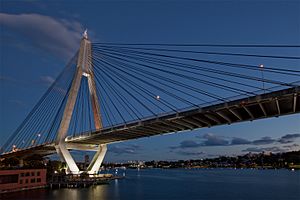
The CBD itself extends about 3 kilometres (1.9 miles) south from Sydney Cove. It is bordered by Farm Cove within the Royal Botanic Garden to the east and Darling Harbour to the west. Suburbs surrounding the CBD include Woolloomooloo and Potts Point to the east, Surry Hills and Darlinghurst to the south, Pyrmont and Ultimo to the west, and Millers Point and The Rocks to the north. Most of these suburbs measure less than 1 square kilometre (0.4 square miles) in area.
Several localities, distinct from suburbs, exist throughout Sydney's inner reaches. Central and Circular Quay are transport hubs with ferry, rail, and bus interchanges. Chinatown, Darling Harbour, and Kings Cross are important locations for culture, tourism, and recreation. The Strand Arcade, which is located between between Pitt Street Mall and George Street, is a historical Victorian-style shopping arcade. Opened on 1 April 1892, its shop fronts are an exact replica of the original internal shopping facades.
There is a long trend of gentrification amongst Sydney's inner suburbs. Pyrmont located on the harbour was redeveloped from a centre of shipping and international trade to an area of high density housing, tourist accommodation, and gambling. Originally located well outside of the city, Darlinghurst is the location of a former gaol, manufacturing, and mixed housing. The terrace style housing has largely been retained and Darlinghurst has undergone significant gentrification since the 1980s.
Green Square is a former industrial area of Waterloo which is undergoing urban renewal worth $8 billion. On the city harbour edge the historic suburb and wharves of Millers Point are being built up as the new area of Barangaroo. The Millers Point/Barangaroo development has significant controversy regardless of the $6 billion worth of economic activity it is generating. The suburb of Paddington is a well known suburb for its streets of restored terrace houses, Victoria Barracks, and shopping including the weekly Oxford Street markets.
The inner western suburbs include Balmain, which was once a working class industrial and mining town but has undergone extensive gentrification, and Ashfield, which has urban density relatively high for Australia. The main shopping strip of the inner-west suburb Newtown, which is centred in King Street, is the longest and most complete commercial precinct of the late Victorian and Federation period in Australia.
Eastern suburbs
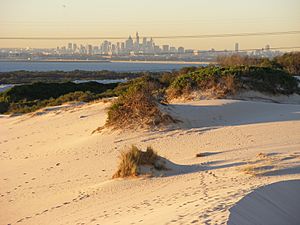
Vaucluse in the eastern suburbs is amongst Australia's most affluent addresses. Neighbouring suburb Point Piper contains Wolseley Road, the ninth most expensive street in the world. Coogee and Bondi, both known for tourism and recreation, are also found in the Eastern Suburbs. Bondi Junction, Sydney's fifth largest business district behind the CBD itself, North Sydney, Parramatta and Chatswood, is a largely commercial area which has undergone many changes since the late 20th century.
The Kurnell peninsula, near Botany Bay, is the site of the first landfall on the eastern coastline made by Lt. (later Captain) James Cook in 1770. La Perouse, a historic suburb named after the French navigator Jean-François de Galaup, comte de Lapérouse (1741–88), is notable for its old military outpost at Bare Island and the Botany Bay National Park. The suburb of Cronulla in southeastern Sydney is close to Royal National Park, Australia's oldest national park. Hurstville, a large suburb with a multitude of commercial buildings and high-rise residential buildings dominating the skyline, has become a central business district for the southern suburbs.
Northern suburbs
Because 'Northern Suburbs' is not a clearly defined region (although having a clearly differently defined lifestyle and social groups over the north shore region), 'Northern Suburbs' may also include the suburbs in the Upper North Shore, Lower North Shore and even the Northern Beaches.
The Northern Suburbs have many landmarks, including Macquarie University, Gladesville Bridge, Ryde Bridge, Macquarie Centre and Westfield Hornsby. This area includes suburbs in the local government areas of Hornsby Shire, City of Ryde and the City of Parramatta. The Northern Suburbs have a well-planned public transport system and substantial bungalow style homes.
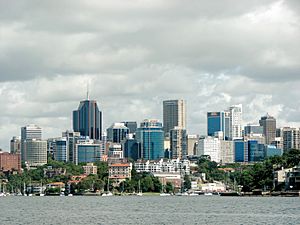
The North Shore, an informal geographic term referring to the northern metropolitan area of Sydney, consists of Artarmon, Chatswood, Roseville, Lindfield, Killara, Gordon, Pymble, Hornsby and many others. The North Shore, an upper middle class area, has one of the highest property prices in Sydney with the recent property price inflation sending the average property prices in suburbs such as Roseville, Lindfield, Killara and Gordon over 2 million dollars.
The North Shore includes the commercial centres of North Sydney and Chatswood. North Sydney itself consists of a large commercial centre, with its own business centre, which contains the second largest concentration of high-rise buildings in Sydney, after the CBD. North Sydney is dominated by advertising, marketing businesses and associated trades, with many large corporations holding office in the region.
The Lower North Shore usually refers to the suburbs adjacent to the harbour such as Neutral Bay, Waverton, Mosman, Cremorne, Cremorne Point, Lavender Bay, Milsons Point, Cammeray, Northbridge, and North Sydney. The Lower North Shore's eastern boundary is Middle Harbour, or at the Roseville Bridge at Castle Cove and Roseville Chase. The Upper North Shore usually refers to the suburbs between Chatswood and Hornsby. It is made up of suburbs located within Ku-ring-gai and Hornsby Shire councils.
The Northern Beaches area includes Manly one of Sydney's most popular holiday destinations for much of the nineteenth and twentieth centuries. The Northern Beaches area extends south to the entrance of Port Jackson (Sydney Harbour), west to Middle Harbour and north to the entrance of Broken Bay. The 2011 Australian census found the Northern Beaches to be the most white and mono-ethnic district in Australia, contrasting with its more-diverse neighbours, the North Shore and the Central Coast.
Western suburbs
The greater western suburbs encompasses the areas of Parramatta, the sixth largest business district in Australia, Bankstown, Liverpool, Penrith, and Fairfield. Covering 5,800 square kilometres (2,200 sq mi) and having an estimated resident population as at 30 June 2008 of 1,665,673, western Sydney has the most multicultural suburbs in the country. The population is predominantly of a working class background, with major employment in the heavy industries and vocational trade.
The western suburb of Prospect, in the City of Blacktown, is home to Wet'n'Wild, a water park operated by Village Roadshow Theme Parks. Auburn Botanic Gardens, a botanical garden situated in Auburn, attracts thousands of visitors each year, including a significant number from outside Australia. The greater west also includes Sydney Olympic Park, a suburb created to host the 2000 Summer Olympics, and Sydney Motorsport Park, a motorsport circuit located in Eastern Creek.
To the northwest, Featherdale Wildlife Park, an Australian zoo in Doonside, near Blacktown, is a major tourist attraction, not just for Western Sydney, but for NSW and Australia. Westfield Parramatta in Parramatta is Australia's busiest Westfield shopping centre, having 28.7 million customer visits per annum.
Further to the south west is the region of Macarthur and the city of Campbelltown, a significant population centre until the 1990s considered a region separate to Sydney proper. Macarthur Square, a shopping complex in Campbelltown, become one of the largest shopping complexes in Sydney.
Urban structure
Architecture
The earliest structures in the colony were built to the bare minimum of standards. Governor Macquarie set ambitious targets for the design of new construction projects. The city now has a world heritage listed building, several national heritage listed buildings, and dozens of Commonwealth heritage listed buildings as evidence of the survival of Macquarie's ideals.
In 1814, the Governor called on a convict named Francis Greenway to design Macquarie Lighthouse. The lighthouse's Classical design earned Greenway a pardon from Macquarie in 1818 and introduced a culture of refined architecture that remains to this day. Greenway went on to design the Hyde Park Barracks in 1819 and the Georgian style St James's Church in 1824. Gothic-inspired architecture became more popular from the 1830s. John Verge's Elizabeth Bay House and St Philip's Church of 1856 were built in Gothic Revival style along with Edward Blore's Government House of 1845. Kirribilli House, completed in 1858, and St Andrew's Cathedral, Australia's oldest cathedral, are rare examples of Victorian Gothic construction.
From the late 1850s there was a shift towards Classical architecture. Mortimer Lewis designed the Australian Museum in 1857. The General Post Office, completed in 1891 in Victorian Free Classical style, was designed by James Barnet. Barnet also oversaw the 1883 reconstruction of Greenway's Macquarie Lighthouse. Customs House was built in 1844. The neo-Classical and French Second Empire style Town Hall was completed in 1889. Romanesque designs gained favour from the early 1890s. Sydney Technical College was completed in 1893 using both Romanesque Revival and Queen Anne approaches. The Queen Victoria Building was designed in Romanesque Revival fashion by George McRae; completed in 1898, it accommodates 200 shops across its three storeys.
As the wealth of the settlement increased and Sydney developed into a metropolis after Federation in 1901, its buildings became taller. Sydney's first tower was Culwulla Chambers which topped out at 50 metres (160 feet) making 12 floors. The Commercial Traveller's Club, built in 1908, was of similar height at 10 floors. It was built in a brick stone veneer and demolished in 1972. This heralded a change in Sydney's cityscape and with the lifting of height restrictions in the 1960s there came a surge of high-rise construction.
The Great Depression had a tangible influence on Sydney's architecture. New structures became more restrained with far less ornamentation. The most notable architectural feat of this period is the Harbour Bridge. Its steel arch was designed by John Bradfield and completed in 1932. A total of 39,000 tonnes of structural steel span the 503 metres (1,650 feet) between Milsons Point and Dawes Point.

Modern and International architecture came to Sydney from the 1940s. Since its completion in 1973 the city's Opera House has become a World Heritage Site and one of the world's most renowned pieces of Modern design. Jørn Utzon was awarded the Pritzker Prize in 2003 for his work on the Opera House. Sydney is home to Australia's first building by renowned Canadian-American architect Frank Gehry, the Dr Chau Chak Wing Building (2015). An entrance from The Goods Line–a pedestrian pathway and former railway line–is located on the eastern border of the site.
Contemporary buildings in the CBD include Citigroup Centre, Aurora Place, Chifley Tower, the Reserve Bank building, Deutsche Bank Place, MLC Centre, and Capita Centre. The tallest structure is Sydney Tower, designed by Donald Crone and completed in 1981. Due to the proximity of Sydney Airport, a maximum height restriction was imposed, now sitting at 330 metres (1083 feet). Green bans and heritage overlays have been in place since at least 1977 to protect Sydney's heritage after controversial demolitions in the 1970s.
Housing
Sydney surpasses both New York City and Paris real estate prices, having some of the most expensive in the world. The city remains Australia's most expensive housing market, with the median house price at $1,595,310 as of December 2023 It is only second to Hong Kong with the average property costing 14 times the annual Sydney salary as of December 2016.
There were 1.83 million dwellings in Sydney in 2021 including 900,000 (54%) detached houses, 218,000 (13%) semi-detached terrace houses and 550,000 (33%) units and apartments. Whilst terrace houses are common in the inner city areas, detached houses dominate the landscape in the outer suburbs. Due to environmental and economic pressures, there has been a noted trend towards denser housing, with a 30% increase in the number of apartments between 1996 and 2006. Public housing in Sydney is managed by the Government of New South Wales. Suburbs with large concentrations of public housing include Claymore, Macquarie Fields, Waterloo, and Mount Druitt.
A range of heritage housing styles can be found throughout Sydney. Terrace houses are found in the inner suburbs such as Paddington, The Rocks, Potts Point and Balmain, many of which have been the subject of gentrification. These terraces, particularly those in suburbs such as The Rocks, were historically home to Sydney's miners and labourers. In the present day, terrace houses now make up some of the most valuable real estate in the city. Surviving large mansions from the Victorian era are mostly found in the oldest suburbs, such as Double Bay, Darling Point, Rose Bay and Strathfield.
Federation homes, constructed around the time of Federation in 1901, are located in a large number of suburbs that developed thanks to the arrival of railways in the late 19th century, such as Penshurst and Turramurra, and in large-scale planned "garden suburbs" such as Haberfield. Workers cottages are found in Surry Hills, Redfern, and Balmain. California bungalows are common in Ashfield, Concord, and Beecroft. Larger modern homes are predominantly found in the outer suburbs, such as Stanhope Gardens, Kellyville Ridge, Bella Vista to the northwest, Bossley Park, Abbotsbury, and Cecil Hills to the west, and Hoxton Park, Harrington Park, and Oran Park to the southwest.
Parks and open spaces
The Anzac War Memorial in Hyde Park is a public memorial dedicated to the Australian Imperial Force of World War I.
The Royal Botanic Garden is the most iconic green space in the region, hosting both scientific and leisure activities. There are 15 separate parks under the City administration. Parks within the city centre include Hyde Park, The Domain and Prince Alfred Park.

The Centennial Parklands is the largest park in the City of Sydney, comprising 189 ha (470 acres).
The inner suburbs include Centennial Park and Moore Park in the east (both within the City of Sydney local government area), while the outer suburbs contain Sydney Park and Royal National Park in the south, Ku-ring-gai Chase National Park in the north, and Western Sydney Parklands in the west, which is one of the largest urban parks in the world. The Royal National Park was proclaimed in 1879 and with 13,200 hectares (51 square miles) is the second oldest national park in the world.
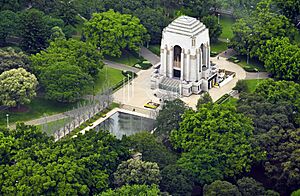
Hyde Park is the oldest parkland in the country. The largest park in the Sydney metropolitan area is Ku-ring-gai Chase National Park, established in 1894 with an area of 15,400 hectares (59 square miles). It is regarded for its well-preserved records of indigenous habitation – more than 800 rock engravings, cave drawings and middens.
The area now known as The Domain was set aside by Governor Arthur Phillip in 1788 as his private reserve. Under the orders of Macquarie the land to the immediate north of The Domain became the Royal Botanic Garden in 1816. This makes them the oldest botanic garden in Australia. The Gardens host scientific research with herbarium collections, a library and laboratories. The two parks have a total area of 64 hectares (0.2 square miles) with 8,900 individual plant species and receive over 3.5 million annual visits.
To the south of The Domain is Hyde Park, the oldest public parkland in Australia which measures 16.2 hectares (0.1 square miles). Its location was used for both relaxation and grazing of animals from the earliest days of the colony. Macquarie dedicated it in 1810 for the "recreation and amusement of the inhabitants of the town" and named it in honour of Hyde Park in London.
Economy
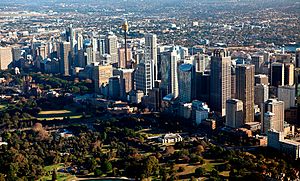
Researchers from Loughborough University have ranked Sydney amongst the top ten world cities that are highly integrated into the global economy. The Global Economic Power Index ranks Sydney eleventh in the world. The Global Cities Index recognises it as fourteenth in the world based on global engagement. There is a significant concentration of foreign banks and multinational corporations in Sydney and the city is promoted as Australia's financial capital and one of Asia Pacific's leading financial hubs.
The prevailing economic theory during early colonial days was mercantilism, as it was throughout most of Western Europe. The economy struggled at first due to difficulties in cultivating the land and the lack of a stable monetary system. Governor Macquarie created two coins from every Spanish silver dollar in circulation. The economy was capitalist in nature by the 1840s as the proportion of free settlers increased, the maritime and wool industries flourished, and the powers of the East India Company were curtailed.
Wheat, gold, and other minerals became export industries towards the end of the 1800s. Significant capital began to flow into the city from the 1870s to finance roads, railways, bridges, docks, courthouses, schools and hospitals. Protectionist policies after federation allowed for the creation of a manufacturing industry which became the city's largest employer by the 1920s. These same policies helped to relieve the effects of the Great Depression during which the unemployment rate in New South Wales reached as high as 32%. From the 1960s onwards Parramatta gained recognition as the city's second CBD and finance and tourism became major industries and sources of employment.
Sydney's nominal gross domestic product was AU$400.9 billion and AU$80,000 per capita in 2015. Its gross domestic product was AU$337 billion in 2013, the largest in Australia. The financial and insurance services industry accounts for 18.1% of gross product, ahead of professional services with 9% and manufacturing with 7.2%. The creative and technology sectors are also focus industries for the City of Sydney and represented 9% and 11% of its economic output in 2012.
Businesses
There were 451,000 businesses based in Sydney in 2011, including 48% of the top 500 companies in Australia and two-thirds of the regional headquarters of multinational corporations. Global companies are attracted to the city in part because its time zone spans the closing of business in North America and the opening of business in Europe. Most foreign companies in Sydney maintain significant sales and service functions but comparably less production, research, and development capabilities. There are 283 multinational companies with regional offices in Sydney.
Domestic economics
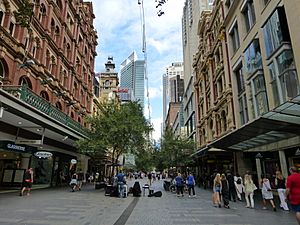
Sydney has been ranked between the fifteenth and the fifth most expensive city in the world and is the most expensive city in Australia. Of the 15 categories only measured by UBS in 2012, workers receive the seventh highest wage levels of 77 cities in the world. Working residents of Sydney work an average of 1,846 hours per annum with 15 days of leave.
The labour force of Greater Sydney Region in 2016 was 2,272,722 with a participation rate of 61.6%. It comprised 61.2% full-time workers, 30.9% part-time workers, and 6.0% unemployed individuals. The largest reported occupations are professionals, clerical and administrative workers, managers, technicians and trades workers, and community and personal service workers. The largest industries by employment across Greater Sydney are Health Care and Social Assistance (11.6%), Professional Services (9.8%), Retail Trade (9.3%), Construction (8.2%), Education and Training (8.0%), Accommodation and Food Services (6.7%), and Financial and Insurance Services (6.6%). The Professional Services and Financial and Insurance Services industries account for 25.4% of employment within the City of Sydney.
In 2016, 57.6% of working-age residents had a weekly income of less than $1,000 and 14.4% had a weekly income of $1,750 or more. The median weekly income for the same period was $719 for individuals, $1,988 for families, and $1,750 for households.
Unemployment in the City of Sydney averaged 4.6% for the decade to 2013, much lower than the current rate of unemployment in Western Sydney of 7.3%. Western Sydney continues to struggle to create jobs to meet its population growth despite the development of commercial centres like Parramatta. Each day about 200,000 commuters travel from Western Sydney to the CBD and suburbs in the east and north of the city.
Home ownership in Sydney was less common than renting prior to the Second World War but this trend has since reversed. Median house prices have increased by an average of 8.6% per annum since 1970. The median house price in March 2014 was $630,000. The primary cause of rising prices is the increasing cost of land and scarcity. 31.6% of dwellings in Sydney are rented, 30.4% are owned outright and 34.8% are owned with a mortgage. 11.8% of mortgagees in 2011 had monthly loan repayments of less than $1,000 and 82.9% had monthly repayments of $1,000 or more. 44.9% of renters for the same period had weekly rent of less than $350 whilst 51.7% had weekly rent of $350 or more. The median weekly rent in Sydney in 2011 was $450.
Financial services
Macquarie gave a charter in 1817 to form the first bank in Australia, the Bank of New South Wales. New private banks opened throughout the 1800s but the financial system was unstable. Bank collapses were frequent and a crisis point was reached in 1893 when 12 banks failed.
The Bank of New South Wales exists to this day as Westpac. The Commonwealth Bank of Australia was formed in Sydney in 1911 and began to issue notes backed by the resources of the nation. It was replaced in this role in 1959 by the Reserve Bank of Australia, also based in Sydney. The Australian Securities Exchange began operating in 1987 and with a market capitalisation of $1.6 trillion is now one of the ten largest exchanges in the world.
The Financial and Insurance Services industry now constitutes 43% of the economic product of the City of Sydney. Sydney makes up half of Australia's finance sector and has been promoted by consecutive Commonwealth Governments as Asia Pacific's leading financial centre. In the 2017 Global Financial Centres Index, Sydney was ranked as having the eighth most competitive financial centre in the world.
In 1985 the Federal Government granted 16 banking licences to foreign banks and now 40 of the 43 foreign banks operating in Australia are based in Sydney, including the People's Bank of China, Bank of America, Citigroup, UBS, Mizuho Bank, Bank of China, Banco Santander, Credit Suisse, Standard Chartered, State Street, HSBC, Deutsche Bank, Barclays, Royal Bank of Canada, Société Générale, Royal Bank of Scotland, Sumitomo Mitsui, ING Group, BNP Paribas, and Investec.
Manufacturing
Sydney has been a manufacturing city since the 1920s. By 1961 the industry accounted for 39% of all employment and by 1970 over 30% of all Australian manufacturing jobs were in Sydney. Its status has declined in recent decades, making up 12.6% of employment in 2001 and 8.5% in 2011. Between 1970 and 1985 there was a loss of 180,000 manufacturing jobs. Despite this, Sydney still overtook Melbourne as the largest manufacturing centre in Australia in the 2010s, with a manufacturing output of $21.7 billion in 2013. Observers have credited Sydney's focus on the domestic market and high-tech manufacturing for its resilience against the high Australian dollar of the early 2010s. The Smithfield-Wetherill Park Industrial Estate in Western Sydney is the largest industrial estate in the Southern Hemisphere and is the centre of manufacturing and distribution in the region.
Tourism and international education

Sydney is a gateway to Australia for many international visitors and ranks among the top sixty most visited cities in the world. It has hosted over 2.8 million international visitors in 2013, or nearly half of all international visits to Australia. These visitors spent 59 million nights in the city and a total of $5.9 billion. The countries of origin in descending order were China, New Zealand, the United Kingdom, the United States, South Korea, Japan, Singapore, Germany, Hong Kong, and India.
The city also received 8.3 million domestic overnight visitors in 2013 who spent a total of $6 billion. 26,700 workers in the City of Sydney were directly employed by tourism in 2011. There were 480,000 visitors and 27,500 people staying overnight each day in 2012. On average, the tourism industry contributes $36 million to the city's economy per day.
Popular destinations include the Sydney Opera House, the Sydney Harbour Bridge, Watsons Bay, The Rocks, Sydney Tower, Darling Harbour, the Royal Botanic Garden, the Australian Museum, the Museum of Contemporary Art, the Art Gallery of New South Wales, the Queen Victoria Building, Sea Life Sydney Aquarium, Taronga Zoo, Bondi Beach, Luna Park and Sydney Olympic Park.
Major developmental projects designed to increase Sydney's tourism sector include a casino and hotel at Barangaroo and the redevelopment of East Darling Harbour, which involves a new exhibition and convention centre, now Australia's largest.
Sydney is the highest-ranking city in the world for international students. More than 50,000 international students study at the city's universities and a further 50,000 study at its vocational and English language schools. International education contributes $1.6 billion to the local economy and creates demand for 4,000 local jobs each year.
Housing affordability
In 2023, Sydney was ranked the least affordable city to buy a house in Australia and the second least affordable city in the world, after Hong Kong, with the average Sydney house price in late 2023 costing A$1.59 million, and the average unit price costing A$795,000. As of early 2024, Sydney is often described in the media as having a housing shortage, or suffering a housing crisis.
Demographics

The population of Sydney in 1788 was less than 1,000. With convict transportation it almost tripled in ten years to 2,953. For each decade since 1961 the population has increased by more than 250,000. The 2021 census recorded the population of Greater Sydney as 5,231,150. The Australian Treasury expects the population will grow to 6.5 million in 2033–34. The four most densely populated suburbs in Australia are located in Sydney with each having more than 13,000 residents per square kilometre (33,700 residents per square mile). Between 1971 and 2018, Sydney experienced a net loss of 716,832 people to the rest of Australia, but its population grew due to overseas arrivals and a healthy birth rate.
The median age of Sydney residents is 37 and 14.8% of people are 65 or older. 48.6% of Sydney's population is married whilst 36.7% have never been married. 49.0% of families are couples with children, 34.4% are couples without children, and 14.8% are single-parent families.
Ancestry and immigration
| Birthplace | Population |
|---|---|
| Australia | 2,752,119 |
| Mainland China | 224,685 |
| England | 151,614 |
| India | 130,573 |
| Greece | 127,274 |
| New Zealand | 86,526 |
| Vietnam | 81,045 |
| Philippines | 75,480 |
| Lebanon | 55,979 |
| South Korea | 49,508 |
| Hong Kong | 40,577 |
| Italy | 40,492 |
| Iraq | 39,237 |
| South Africa | 35,313 |
| Fiji | 31,510 |
| Nepal | 30,424 |
| Indonesia | 29,989 |
| Malaysia | 21,211 |
Most immigrants to Sydney between 1840 and 1930 were British, Irish or Chinese. At the 2016 census, the most commonly nominated ancestries were:
- English (27%)
- Australian (25%)
- Chinese (10.8%)
- Irish (9.2%)
- Scottish (6.8%)
- Italian (4.5%)
- Indian (4.3%)
- Lebanese (3.5%)
- German (2.7%)
- Greek (2.6%)
- Vietnamese (2.3%)
- Filipino (2.3%)
- Indigenous (1.5%)
- Korean (1.4%)
- Maltese (1.3%)
At the 2016 census, there were 2,071,872 people living in Sydney that were born outside the country, accounting for 42.9% of the population, below Miami (58.3%) and Toronto (47.0%), but above Vancouver (42.5%), Los Angeles (37.7%), New York City (37.5%), Chicago (20.7%), Paris (14.6%) and Berlin (13%). Only 33.1% of the population had both parents born in Australia. Sydney has the eighth-largest immigrant population among world metropolitan areas. Foreign countries of birth with the greatest representation are Mainland China, England, India, New Zealand, Vietnam and the Philippines.
1.5% of the population, or 70,135 people, identified as Indigenous Australians (Aboriginal Australians and Torres Strait Islanders) in 2016.
Language
38.2% of people in Sydney speak a language other than English at home with Mandarin (4.7%), Arabic (4.0%), Cantonese (2.9%), Vietnamese (2.1%) and Greek (1.6%) the most widely spoken. At the time of the 2011 census, more than 250 different languages were spoken in Sydney. In the 2016 Census, about 35.8% of residents spoke a language other than English at home.
Religion
The indigenous people of Sydney held totemic beliefs known as "dreamings". Governor Lachlan Macquarie made an effort to found a culture of formal religion throughout the early settlement and ordered the construction of churches such as St Matthew's, St Luke's, St James's, and St Andrew's. In 2011, 28.3% of Sydney residents identified themselves as Catholic, whilst 17.6% practised no religion. Additionally, 16.1% were Anglican, 4.7% were Muslim, 4.2% were Eastern Orthodox, 4.1% were Buddhist, 2.6% were Hindu, and 0.9% were Jewish. However, according to the 2016 census, 1,082,448 (25%) residents of Sydney's Urban Centre describe themselves as Catholic, while another 1,053,500 (24.4%) people consider themselves non-religious. A further 10.9% of residents identified themselves as Anglicans and an additional 5.8% as Muslim. These and other religious institutions have significantly contributed to the education and health of Sydney's residents over time, particularly through the building and management of schools and hospitals.
Culture
Science, art, and history
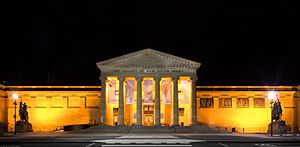
Ku-ring-gai Chase National Park is rich in Indigenous Australian heritage, containing around 1,500 pieces of Aboriginal rock art – the largest cluster of Indigenous sites in Australia. The park's indigenous sites include petroglyphs, art sites, burial sites, caves, marriage areas, birthing areas, midden sites, and tool manufacturing locations, which are dated to be around 5,000 years old. The inhabitants of the area were the Garigal people. Other rock art sites exist in the Sydney region, such as in Terrey Hills and Bondi, although the locations of most are not publicised to prevent damage by vandalism, and to retain their quality, as they are still regarded as sacred sites by Indigenous Australians.

The Australian Museum opened in Sydney in 1827 with the purpose of collecting and displaying the natural wealth of the colony. It remains Australia's oldest natural history museum. In 1995 the Museum of Sydney opened on the site of the first Government House. It recounts the story of the city's development. Other museums include the Powerhouse Museum and the Australian National Maritime Museum.
The State Library of New South Wales holds the oldest library collections in Australia, being established as the Australian Subscription Library in 1826. The Royal Society of New South Wales, formed in 1866, encourages "studies and investigations in science, art, literature, and philosophy". It is based in a terrace house in Darlington owned by the University of Sydney. The Sydney Observatory building was constructed in 1859 and used for astronomy and meteorology research until 1982 before being converted into a museum.
The Museum of Contemporary Art was opened in 1991 and occupies an Art Deco building in Circular Quay. Its collection was founded in the 1940s by artist and art collector John Power and has been maintained by the University of Sydney. Sydney's other significant art institution is the Art Gallery of New South Wales which coordinates the Archibald Prize for portraiture. Sydney is also home to contemporary art gallery Artspace, housed in the historic Gunnery Building in Woolloomooloo, fronting Sydney Harbour.
Entertainment
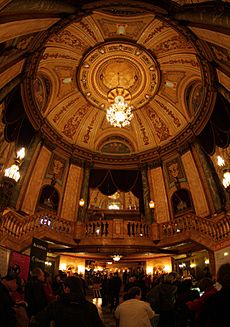
Sydney's first commercial theatre opened in 1832 and nine more had commenced performances by the late 1920s. The live medium lost much of its popularity to the cinema during the Great Depression before experiencing a revival after World War II. Prominent theatres in the city today include State Theatre, Theatre Royal, Sydney Theatre, The Wharf Theatre, and Capitol Theatre. Sydney Theatre Company maintains a roster of local, classical, and international plays. It occasionally features Australian theatre icons such as David Williamson, Hugo Weaving, and Geoffrey Rush. The city's other prominent theatre companies are New Theatre, Belvoir, and Griffin Theatre Company. Sydney is also home to Event Cinemas' first theatre, which opened on George St in 1913, under its former Greater Union brand; the theatre currently operates, and is regarded as one of Australia's busiest cinema locations.
The Sydney Opera House is the home of Opera Australia and Sydney Symphony. It has staged over 100,000 performances and received 100 million visitors since opening in 1973. Two other important performance venues in Sydney are Town Hall and the City Recital Hall. The Sydney Conservatorium of Music is located adjacent to the Royal Botanic Garden and serves the Australian music community through education and its biannual Australian Music Examinations Board exams.

Many writers have originated in and set their work in Sydney. Others have visited the city and commented on it. Some of them are commemorated in the Sydney Writers Walk at Circular Quay. The city was the headquarters for Australia's first published newspaper, the Sydney Gazette. Watkin Tench's A Narrative of the Expedition to Botany Bay (1789) and A Complete Account of the Settlement at Port Jackson in New South Wales (1793) have remained the best-known accounts of life in early Sydney. Since the infancy of the establishment, much of the literature set in Sydney were concerned with life in the city's slums and working-class communities, notably William Lane's The Working Man's Paradise (1892), Christina Stead's Seven Poor Men of Sydney (1934) and Ruth Park's The Harp in the South (1948). The first Australian-born female novelist, Louisa Atkinson, set several novels in Sydney. Contemporary writers, such as Elizabeth Harrower, were born in the city and set most of their work there–Harrower's debut novel Down in the City (1957) was mostly set in a King's Cross apartment. Well known contemporary novels set in the city include Melina Marchetta's Looking for Alibrandi (1992), Peter Carey's 30 Days in Sydney: A Wildly Distorted Account (1999), J. M. Coetzee's Diary of a Bad Year (2007) and Kate Grenville's The Secret River (2010). The Sydney Writers' Festival is held annually between April and May.
Filmmaking in Sydney was prolific until the 1920s when spoken films were introduced and American productions gained dominance. The Australian New Wave saw a resurgence in film production, with many notable features shot in the city between the 1970s and 80s, helmed by directors such as Bruce Beresford, Peter Weir and Gillian Armstrong. Fox Studios Australia commenced production in Sydney in 1998. Successful films shot in Sydney since then include The Matrix, Lantana, Mission: Impossible 2, Moulin Rouge!, Star Wars: Episode II – Attack of the Clones, Australia, Superman Returns, and The Great Gatsby. The National Institute of Dramatic Art is based in Sydney and has several famous alumni such as Mel Gibson, Judy Davis, Baz Luhrmann, Cate Blanchett, Hugo Weaving and Jacqueline Mckenzie.
Sydney hosts several festivals throughout the year. The city's New Year's Eve celebrations are the largest in Australia. The Royal Easter Show is held every year at Sydney Olympic Park. Sydney Festival is Australia's largest arts festival. The travelling rock music festival Big Day Out originated in Sydney. The city's two largest film festivals are Sydney Film Festival and Tropfest. Vivid Sydney is an annual outdoor exhibition of art installations, light projections, and music. In 2015, Sydney was ranked the 13th top fashion capital in the world. It hosts the Australian Fashion Week in autumn. Sydney Mardi Gras has commenced each February since 1979.
Sydney's Chinatown has had numerous locations since the 1850s. It moved from George Street to Campbell Street to its current setting in Dixon Street in 1980. Little Italy is located in Stanley Street.
Restaurants, bars and nightclubs can be found in the entertainment hubs in the Sydney CBD (Darling Harbour, Barangaroo, The Rocks and George Street), Oxford Street, Surry Hills, Newtown and Parramatta. ..... The Star is the city's casino and is situated next to Darling Harbour while the new Crown Sydney resort is in nearby Barangaroo.
Media
The Sydney Morning Herald is Australia's oldest newspaper still in print; it has been published continuously since 1831. Its competitor is The Daily Telegraph, in print since 1879. Both papers have Sunday tabloid editions called The Sun-Herald and The Sunday Telegraph respectively. The Bulletin was founded in Sydney in 1880 and became Australia's longest running magazine. It closed after 128 years of continuous publication. Sydney heralded Australia's first newspaper, the Sydney Gazette, published until 1842.
Each of Australia's three commercial television networks and two public broadcasters is headquartered in Sydney. Nine's offices and news studios are in North Sydney, Ten is based in Pyrmont, and Seven is based in South Eveleigh in Redfern. The Australian Broadcasting Corporation is located in Ultimo, and the Special Broadcasting Service is based in Artarmon. Multiple digital channels have been provided by all five networks since 2000. Foxtel is based in North Ryde and sells subscription cable television to most of the urban area. Sydney's first radio stations commenced broadcasting in the 1920s. Radio has managed to survive despite the introduction of television and the Internet. 2UE was founded in 1925 and under the ownership of Nine Entertainment is the oldest station still broadcasting. Competing stations include the more popular 2GB, ABC Radio Sydney, KIIS 106.5, Triple M, Nova 96.9 and 2Day FM.
Sport and outdoor activities
Sydney's earliest migrants brought with them a passion for sport but were restricted by the lack of facilities and equipment. The first organised sports were boxing, wrestling, and horse racing from 1810 in Hyde Park. Horse racing remains popular and events such as the Golden Slipper Stakes attract widespread attention. The first cricket club was formed in 1826 and matches were played within Hyde Park throughout the 1830s and 1840s. Cricket is a favoured sport in summer and big matches have been held at the Sydney Cricket Ground since 1878. The New South Wales Blues compete in the Sheffield Shield league and the Sydney Sixers and Sydney Thunder contest the national Big Bash Twenty20 competition.
First played in Sydney in 1865, rugby grew to be the city's most popular football code by the 1880s. One-tenth of the state's population attended a New South Wales versus New Zealand rugby match in 1907. Rugby league separated from rugby union in 1908. The New South Wales Waratahs contest the Super Rugby competition, while the Sydney Rays represent the city in the National Rugby Championship. The national Wallabies rugby union team competes in Sydney in international matches such as the Bledisloe Cup, Rugby Championship, and World Cup. Sydney is home to nine of the seventeen teams in the National Rugby League competition: Canterbury-Bankstown Bulldogs, Cronulla-Sutherland Sharks, Manly-Warringah Sea Eagles, Penrith Panthers, Parramatta Eels, South Sydney Rabbitohs, St George Illawarra Dragons, Sydney Roosters, and Wests Tigers. New South Wales contests the annual State of Origin series against Queensland.
Sydney FC and the Western Sydney Wanderers compete in the A-League Men and A-League Women competitions. The Sydney Swans and Greater Western Sydney Giants are local Australian rules football clubs that play in the Australian Football League and the AFL Women's. The Sydney Kings compete in the National Basketball League. The Sydney Uni Flames play in the Women's National Basketball League. The Sydney Blue Sox contest the Australian Baseball League. The NSW Pride are a member of the Hockey One League. The Sydney Bears and Sydney Ice Dogs play in the Australian Ice Hockey League. The Swifts are competitors in the national women's netball league.
Major sporting venues
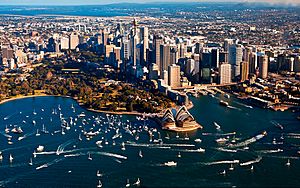
Women were first allowed to participate in recreational swimming when separate baths were opened at Woolloomooloo Bay in the 1830s. From being illegal at the beginning of the century, sea bathing gained immense popularity during the early 1900s and the first surf lifesaving club was established at Bondi Beach. Disputes about appropriate clothing for surf bathing surfaced occasionally and concerned men as well as women. The City2Surf is an annual 14-kilometre (8.7-mile) running race from the CBD to Bondi Beach and has been held since 1971. In 2010, 80,000 runners participated which made it the largest run of its kind in the world.
Sailing races have been held on Sydney Harbour since 1827. Yachting has been popular amongst wealthier residents since the 1840s and the Royal Sydney Yacht Squadron was founded in 1862. The Sydney to Hobart Yacht Race is a 1,170-kilometre (727-mile) event that starts from Sydney Harbour on Boxing Day. Since its inception in 1945 it has been recognised as one of the most difficult yacht races in the world. Six sailors died and 71 vessels of 115 failed to finish in the 1998 edition.
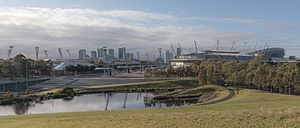
The Royal Sydney Golf Club is based in Rose Bay and since its opening in 1893 has hosted the Australian Open on 13 occasions. Royal Randwick Racecourse opened in 1833 and holds several major cups throughout the year.
Sydney benefitted from the construction of significant sporting infrastructure in preparation for its hosting of the 2000 Summer Olympics. The Sydney Olympic Park accommodates athletics, aquatics, tennis, hockey, archery, baseball, cycling, equestrian, and rowing facilities. It also includes the high capacity Stadium Australia used for rugby, soccer, and Australian rules football. The Sydney Football Stadium was completed in 1988 and was used for rugby and soccer matches. Sydney Cricket Ground was opened in 1878 and is used for both cricket and Australian rules football fixtures.
Sydney was one of the host cities during the 2023 FIFA Women's World Cup. Sydney Football Stadium and Stadium Australia were selected as venues, with the later hosting the final.
The Sydney International tennis tournament is held here at the beginning of each year as the warm-up for the Grand Slam in Melbourne. Two of the most successful tennis players in history (Ken Rosewall and Todd Woodbridge) were born in and live in the city.
Sydney co-hosted the FIBA Oceania Championship in 1979, 1985, 1989, 1995, 2007, 2009 and 2011.
Infrastructure
Education
Education became a focus for the colony from the 1870s when public schools began to form and schooling became compulsory. By 2011, 90% of working age residents had completed some schooling and 57% had completed the highest level of school. 1,390,703 people were enrolled in an educational institution in 2011 with 45.1% of these attending school and 16.5% studying at a university. Undergraduate or postgraduate qualifications are held by 22.5% of working age Sydney residents and 40.2% of working age residents of the City of Sydney. The most common fields of tertiary qualification are commerce (22.8%), engineering (13.4%), society and culture (10.8%), health (7.8%), and education (6.6%).
There are six public universities based in Sydney: The University of Sydney, University of New South Wales, University of Technology Sydney, Macquarie University, Western Sydney University, and Australian Catholic University. Five public universities maintain secondary campuses in the city: the University of Notre Dame Australia, Central Queensland University, Victoria University, University of Wollongong, and University of Newcastle. Charles Sturt University and Southern Cross University operate secondary campuses only designated for international students. In addition, four public universities offer programs in Sydney through third-party providers: University of the Sunshine Coast, La Trobe University, Federation University Australia and Charles Darwin University. 5.2% of residents of Sydney are attending a university. The University of New South Wales and the University of Sydney are ranked equal 19th in the world, the University of Technology Sydney is ranked in the top 100, while Macquarie University is ranked 237, and Western Sydney University is ranked 474. Sydney has public, denominational, and independent schools. 7.8% of Sydney residents are attending primary school and 6.4% are enrolled in secondary school. There are 935 public preschool, primary, and secondary schools in Sydney that are administered by the New South Wales Department of Education. 14 of the 17 selective secondary schools in New South Wales are based in Sydney.
Public vocational education and training in Sydney are run by TAFE New South Wales and began with the opening of the Sydney Technical College in 1878. The college became the Sydney Institute in 1992 and now operates alongside its sister TAFE facilities across the Sydney metropolitan area, namely the Northern Sydney Institute, the Western Sydney Institute, and the South Western Sydney Institute. At the 2011 census, 2.4% of Sydney residents are enrolled in a TAFE course.
Transport
Roads
The motor vehicle, more than any other factor, has determined the pattern of Sydney's urban development since World War II. The growth of low-density housing in the city's outer suburbs has made car ownership necessary for hundreds of thousands of households. The percentage of trips taken by car has increased from 13% in 1947 to 50% in 1960 and 70% in 1971. The most important roads in Sydney were the nine Metroads, including the 110-kilometre (68-mile) Sydney Orbital Network. Sydney's reliance on motor vehicles and its sprawling road network has been criticised by proponents of mass public transport and high-density housing. The Light Horse Interchange in western Sydney is the largest in the southern hemisphere.
There can be up to 350,000 cars using Sydney's roads simultaneously during peak hour, leading to significant traffic congestion. 84.9% of Sydney households own a motor vehicle and 46.5% own two or more. With a rate of 26.3% in 2014, Sydney has the highest utilisation of public transport for travel to work of any Australian capital. In contrast, in 2014 only 25.2% of working residents in the City of Sydney use a car, whilst 15.8% take a train, 13.3% use a bus, and 25.3% walk. Several significant infrastructure projects have been completed since. The CBD features a series of alleyways and lanes that provide off-street vehicular access to city buildings and as well as pedestrian routes through city buildings.
Suburban trains
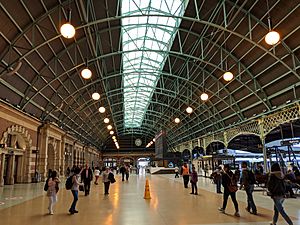
Established in 1906, Central station is the largest and busiest railway station in the state and is the main hub of the city's rail network. Sydney Trains is the suburban rail service. Its tracks form part of the New South Wales railway network. It serves 168 stations across the city and had an annual ridership of 302 million passenger journeys in 2023–24. Sydney's railway was first constructed in 1854 with progressive extension to the network to serve both freight and passengers. The main station is the Central railway station in the southern part of the CBD. In the 1850s and 1860s, the railway reached areas that are now outer suburbs of Sydney.
Metro
Sydney Metro, a driverless rapid transit system separate from the suburban commuter network, commenced operation in May 2019 and was extended through the city to Sydenham on 19 August 2024. This line will be extended to Bankstown in 2025 and a new line through the inner west to Parramatta is planned to be built by 2030. It currently serves 21 stations. A line to serve the greater west is planned for 2026 and will include a station for the second international airport.
Light rail
Sydney once had one of the largest tram networks in the British Empire after London. It served routes covering 291 kilometres (181 miles). The internal combustion engine made buses more flexible than trams and consequently more popular, leading to the progressive closure of the network with the final tram operating in 1961. From 1930 there were 612 buses across Sydney carrying 90 million passengers per annum.
In 1997, the Inner West Light Rail opened between Central station and Wentworth Park. It was extended to Lilyfield in 2000 and then Dulwich Hill in 2014. It links the Inner West and Darling Harbour with Central station and facilitated 9.1 million journeys in the 2016–17 financial year. A second, the CBD and South East Light Rail 12 km (7.5 mi) line serving the CBD and Eastern Suburbs opened in 2019–2020. A light rail line serving Western Sydney opened in 2024.
Buses
Bus services are conducted by private operators under contract to Transport for NSW. Integrated tickets called Opal cards operate on bus routes. In total, nearly 225 million boardings were recorded across the bus network. NightRide is a nightly bus service that operate between midnight and 5am.
Ferries

At the time the Sydney Harbour Bridge opened in 1932, the city's ferry service was the largest in the world. Patronage declined from 37 million passengers in 1945 to 11 million in 1963 but has recovered somewhat in recent years. From its hub at Circular Quay, the ferry network extends from Manly to Parramatta. Ferries in sydney are operated by Transdev Sydney Ferries and operates 10 routes.
Airports
Sydney Airport, officially "Sydney Kingsford-Smith Airport", is located in Mascot. It services 46 international and 23 domestic destinations. As the busiest airport in Australia, it handled 37.9 million passengers in 2013 and 530,000 tonnes of freight in 2011. It has been announced that a new facility named Western Sydney Airport will be constructed at Badgerys Creek from 2016 at a cost of $2.5 billion. Bankstown Airport is Sydney's second busiest airport, and serves general aviation, charter and some scheduled cargo flights. Bankstown is also the fourth busiest airport in Australia by number of aircraft movements. Port Botany has surpassed Port Jackson as the city's major shipping port. Cruise ship terminals are located at Sydney Cove and White Bay.
Utilities
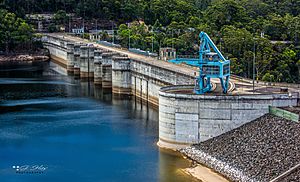
Obtaining sufficient fresh water was difficult during early colonial times. A catchment called the Tank Stream sourced water from what is now the CBD but was little more than an open sewer by the end of the 1700s. The Botany Swamps Scheme was one of several ventures during the mid-1800s that saw the construction of wells, tunnels, steam pumping stations, and small dams to service Sydney's growing population.
The Upper Nepean Scheme came into operation in 1886. It transports water 100 kilometres (62 miles) from the Nepean, Cataract, and Cordeaux rivers and continues to service about 15% of Sydney's water needs. Dams were built on these three rivers between 1907 and 1935. In 1977 the Shoalhaven Scheme brought several more dams into service.
The state-owned corporation WaterNSW now manages eleven major dams: Warragamba, one of the largest domestic water supply dams in the world, Woronora, Cataract, Cordeaux, Nepean, Avon, Wingecarribee Reservoir, Fitzroy Falls Reservoir, Tallowa, the Blue Mountains Dams, and Prospect Reservoir. Water is collected from five catchment areas covering 16,000 square kilometres (6,178 square miles) and total storage amounts to 2.6 teralitres (0.6 cubic miles). The Sydney Desalination Plant came into operation in 2010. WaterNSW supplies bulk water to Sydney Water, a state-owned corporation that operates water distribution, sewerage and storm water management services.
Sydney's electricity infrastructure is maintained by Ausgrid and Endeavour Energy. Their combined networks include over 815,000 poles and 83,000 kilometres (52,000 miles) of cables. Submarine communications cable systems in Sydney include the Australia–Japan Cable, Telstra Endeavour and the Southern Cross Cable, which link Australia and countries in the Pacific.
Environmental issues and pollution reduction
Air quality
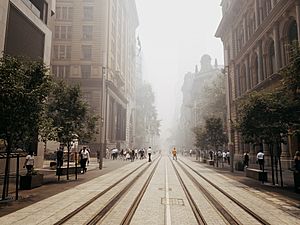
As climate change, greenhouse gas emissions and pollution have become a major issue for Australia, Sydney has in the past been criticised for its lack of focus on reducing pollution and emissions and maintaining water quality. The release of the Metropolitan Air Quality Scheme (MAQS) led to a broader understanding of the causation of pollution in Sydney, allowing the government to form appropriate responses.
The 2019–20 Australian bushfire season significantly impacted outer Sydney and dramatically reduced air quality, leading to a smoky haze that lingered for days. The air quality was 11 times the hazardous level in some days, worse than New Delhi's; it was compared to "smoking 32 cigarettes" by Brian Oliver, a respiratory diseases scientist at the University of Technology Sydney. Since Sydney is surrounded by bushland and forest, bushfires can ring the region in a natural phenomena that is labelled "ring of fire".
The City of Sydney became the first council in Australia to achieve formal certification as carbon-neutral in 2008. The city has reduced its 2007 carbon emissions by 6% and since 2006 has reduced carbon emissions from city buildings by up to 20%. The Sustainable Sydney 2030 program presented a guide to reducing energy in homes and offices by 30%. Reductions in energy consumption have slashed energy bills by $30 million a year. Solar panels have been established on many CBD buildings to minimise carbon pollution by around 3,000 tonnes a year.
The city also has an "urban forest growth strategy", in which it aims to regular increase the tree coverage in the city by frequently planting trees with strong leaf density and vegetation to provide cleaner air and create moisture during hot weather, thus lowering city temperatures. Sydney has also become a leader in the development of green office buildings and enforcing the requirement of all building proposals to be energy-efficient. The One Central Park development, completed in 2013, is an example of this implementation.
Car-dependency
Australian cities are some of the most car-dependent cities in the world, especially by world city standards, although Sydney's is the lowest of Australia's major cities at 66%. Sydney also has the highest usage of public transport in an Australian city, at 27%–comparable with New York City, Shanghai and Berlin. Despite its high ranking for an Australian city, Sydney has a low level of mass-transit services, with a historically low-density layout and significant urban sprawl, thus increasing the likelihood of car dependency.
Strategies have been implemented to reduce private vehicle pollution by encouraging mass and public transit, initiating the development of high density housing and introducing a fleet of 10 new electric cars, the largest order of the pollution-free vehicle in Australia. Electric cars do not produce carbon monoxide and nitrous oxide, which contribute to climate change. Cycling trips increased by 113% across Sydney's inner-city from 2010 to 2015, at which point about 2,000 bikes were passing through top peak-hour intersections on an average weekday. Transport developments in the north-west and east of the city have been designed to encourage use of the expanding public transportation system.
Sister cities
Sister cities of Sydney include:
- San Francisco, United States of America
- Wellington, New Zealand
- Florence, Italy
- Nagoya, Japan
- Portsmouth, United Kingdom
See also
 In Spanish: Sídney para niños
In Spanish: Sídney para niños








